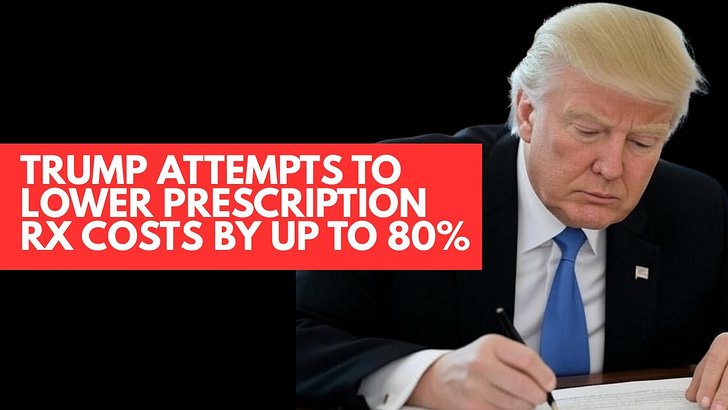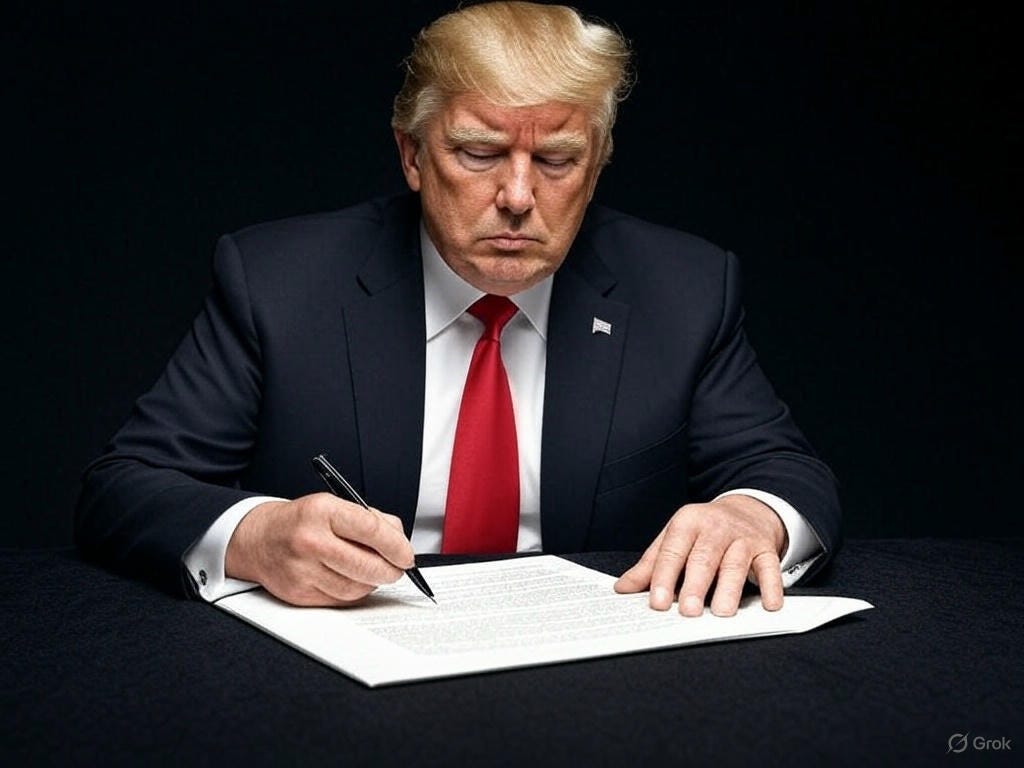May 12, 2025 — On The Pen
President Donald J. Trump just signed one of the most aggressive moves we have seen in modern history to bring down prescription drug prices in America. The Executive Order lays out a detailed plan to take on the system of global price discrimination that has left American patients paying the highest costs in the world. We’re going to break it all down for the community, and try to avoid the political minefield that is anything related to the current president in the process.
For this community, the long-term cost of treating the chronic disease of obesity is real. This potentially massive move is worth our open and respectful discussion, even if it turns some people off. If you’d like to watch our coverage of the White House Press Briefing from this morning, you can do that here:
Let’s get into it…
Why This Order Matters
America has less than five percent of the world’s population, but we fund nearly three quarters of global pharmaceutical profits. We also fund the research behind many scientific break throughs with American tax-payer funded health programs. We fund all this, all while we continue to pay the highest retail prices in the world. In short, we subsidize the world. And in a world where so many are struggling to make ends meet, the cost of prescription drugs has exploded 70% since 2000.
This Executive Order calls it all out for what it is. A rigged system. In short, it directs the government to stop allowing foreign countries to negotiate lower prices while Americans pay two or three times more for the same medicine.
The goal is simple. The U.S. should not be charged more than any other developed nation for the same drug. At it’s heart is the idea that the world needs an equalization reset when it comes to footing the bill for medical innovation. That concept is called "Most Favored Nation" pricing.
How Will the Government Enforce Such a Policy?
I’m glad you asked. Today’s press conference left us all wanting more meat on the bone, but the language of the actual executive order went far beyond the imprecise action plan, and pre-emptive victory lap taken in this morning’s presser.
The order signed May 12 outlines six major steps:
First, Most Favored Nation pricing is now the standard.
HHS has 30 days to notify pharmaceutical companies that they are expected to match the lowest price they offer in any similarly developed country.
Second, direct to consumer access.
HHS is instructed to create a pathway that allows drug companies to sell medications directly to patients at those same lower prices, without insurance or pharmacy middlemen getting in the way. Think in terms of the federal government using it’s levers of policy and enforcement to grease-the-skids for direct to consumer offerings like Lilly Direct and NovoCare.
Third, importation is on the table.
If drugmakers do not comply, the administration may approve the import of safe, lower cost drugs from other countries. If you have followed the compound GLP-1 saga, you know well that API’s for pharmaceutical drugs are made available to compounders in the USA, and able to be brought to market well below brand-name list price drugs. Could this be the administration’s nod to the role of compounding pharmacies in reducing prescription drug cost? It very well may be.
Fourth, antitrust enforcement.
The Justice Department and the Federal Trade Commission are ordered to investigate any price fixing or market manipulation that may be keeping drug prices artificially high.
Fifth, possible export restrictions.
The government may review whether the export of raw materials or drugs is driving up domestic costs and take action to address it.
Sixth, FDA leverage.
The FDA is directed to review whether certain drugs that are overpriced or poorly marketed should have their approvals reexamined.
Why It Might Work This Time
Trump tried something like this in 2020, but it got blocked in court, and then subsequently dropped entirely by the Biden administration. The reason it got snagged in the first place is that the first Trump administration skipped a required public comment period when pushing the rule through Medicare. That opened the door for pharma companies to sue.
This time is different.
Thanks to the Inflation Reduction Act passed in 2022, Medicare now has new authority to negotiate drug prices. That gives the administration a stronger legal foundation. If they go through the right process, this could be legally enforceable and much harder to stop.
Will This Help People With Private Insurance?
Yes, but not overnight, and not without a serious fight.
This Executive Order starts with Medicare, but if it works, it sets a powerful benchmark that will ripple through the rest of the system. Once the government secures lower prices, employers and insurers will demand the same. Pharma companies, already under fire for charging Americans several times more than other nations, will not be able to maintain two different price lists without major pushback.
But here is what changes the game. During his press conference, President Trump said this will not just be a domestic fight. It is a global strategy. He announced that the administration will work directly with pharmaceutical companies based in the United States to coordinate price negotiations with the European Union, among others. His message was clear. If Europe wants access to American innovation, it needs to start paying its share. And if not, the United States may start using trade pressure, including limiting European auto imports, to get results.
That is a major shift. For years, the U.S. government and the pharmaceutical industry have been at odds over drug pricing. Now Trump is saying they will work together to end the global free ride and push other countries to the table.
And to be honest, it might be the only way this works.
Most Favored Nation pricing cannot be imposed in a vacuum. If companies are expected to lower prices here, they will need leverage to raise prices elsewhere. That means the federal government has to be part of the solution, not just the enforcer. Trade negotiations, global supply chains, and coordinated policy are going to matter just as much as domestic rulemaking.
Whether this new alliance between pharma and the administration actually holds remains to be seen. But if it does, this strategy could reset not just Medicare prices, but the entire drug pricing landscape in the United States, and that includes private insurance.
What About GLP-1 Meds Like Zepbound and Wegovy?
One of the most compelling pieces of this Executive Order is the call for HHS to help set up programs where drug companies sell directly to patients at the lowest price they offer in other developed countries. That means if a medication costs 160 dollars in France, this order says it should be made available to American patients for the same price, no inflated markups, no middle layers.
We are already seeing this idea take shape. LillyDirect and NovoCare are early examples. Both allow manufacturers to sell medications straight to patients, usually online, often with simplified pricing and less insurance red tape. For some patients, especially those paying cash or locked out of coverage, these programs can feel like a lifeline. But they also raise a red flag.
Most local pharmacies are being left behind. These new direct to consumer programs are built without them. Patients never walk in. Prescriptions are not filled across a counter. Pharmacists are cut out of the equation almost entirely. And that is a problem.
Pharmacies are more than just a place to pick up pills. They are part of the care team. They catch dosing mistakes. They know which meds interact. They help people who do not have a doctor or who cannot reach one. If we let direct to consumer become the new normal without a plan to support pharmacies, we risk gutting one of the most accessible parts of our healthcare system.
So yes, we should push for affordability. Patients deserve that. But if we do not make room for local pharmacies in this new model, we could win on price and still lose on care.
What Comes Next
HHS has 30 days to send new pricing expectations to pharmaceutical companies.
If drugmakers fail to adjust prices, a new rulemaking process can begin.
That process includes public comment and legal review but ends with the government having the power to mandate lower prices.
Importation pathways, legal enforcement, and approval reviews are also on standby if companies resist.
This May Have the Ability To Truly Change Things, We Should All Want That
This is not just another headline. It is a coordinated, full government effort to say enough is enough. Something we have been advocating for loudly. Americans should not be paying triple for the same drug. If this order survives the next few months of legal and regulatory steps, it could change the price of medicine in this country forever.
For patients using GLP-1s, or anyone who has struggled to afford the prescriptions they need to survive, this moment matters.
Help Us Grow.
If this made something click for you, or if you are tired of watching other countries pay a fraction of what we do for the same medication, if you have been shut out by your insurance, or if you have ever stood at the pharmacy counter wondering how you are going to afford your next refill… Please share this. Help us GET LOUD!
Share it in your Facebook groups, your Reddit threads, your text chains, anywhere people are talking about access and feeling forgotten. This is not about politics. It is about whether we finally build a system that stops punishing the sick and starts fighting for them.
And if you believe in what we are building here, if you want to keep seeing this kind of patient centered reporting, then subscribe to this Substack. Consider becoming a paid supporter. Or if you just want to throw five bucks in the tip jar to help fuel the work, you can Venmo a gift to @OnThePen.
Every share matters. Every subscriber counts. Every dollar helps keep this mission alive. We are not done yet.
Let’s keep pushing. Let’s not waste the moment.






I wish he would do away with the contract language PBM’s use that doesn’t allow pharmacists to disclose to consumers about pricing and if cash pay/goodrx is less than the covered insurance negotiated price! It’s absolutely infuriating!!